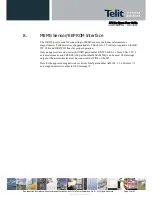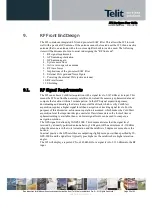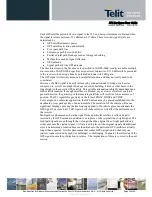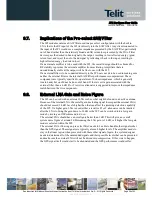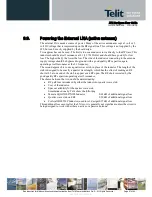
JF2 Hardware User Guide
1vv0300985 Rev.4 2013-04-09
Reproduction forbidden without written authorization from Telit Communications S.p.A. - All Rights Reserved.
Page 33 of 40
Mod. 0805 2011-07 Rev.2
11.2.3.
Push-To-Fix
This mode provides for even lower power consumption than TricklePower. It is intended for
applications that require infrequent position reports. The position is reported periodically by
the receiver (once every 30 minutes by default) and also when requested. To request a
position update, a pulse is asserted on the ON-OFF pin.
11.2.4.
Micro Power Mode (MPM)
Micro Power mode is the lowest power operating mode. Rather than providing position
updates at a reduced rate, it is predicated on maintaining the availability of a navigation
solution by maintaining hot start conditions in the receiver at all times. The receiver is put
into Full Power by pulsing the ON-OFF pin. It is put back into Micro Power mode by
sending a Power Mode Request command to the receiver.
11.3.
Host Serial Interface
As mentioned above in Section 7, the host serial interface can be configured as a UART, I2C
or SPI port by strapping one or both pins GPIO 6 and GPIO 7 to certain levels at power up.
The data rate for I2C is fixed at 400 kbps. The slave SPI supports a maximum clock input rate
of 6.8 MHz. The UART can operate at baud rates of 4800, 9600, 19200, 38400, 57600,
115200, 230400 and 460800 bps.
11.3.1.
NMEA Protocol Considerations
The lower UART baud rates are typically used for NMEA protocol. Note should be taken
however of the bandwidth limitation at 4800 baud. By default, the JF2 module communicates
using NMEA at 4800 baud, with the periodic output messages limited to the GGA, GSA and
RMC messages at once per second and the GSV message once every five seconds. At 9600
baud or higher, additional output messages may be enabled.
If the JF2 is operated in TricklePower mode, a baud rate of at least 38400 is recommended.
This reduces the time required for data output and allows the receiver to drop into the lowest
power state for a longer average time.
Use the Set Serial Port (PSRF100) NMEA command to change the baud rate. This command
can also be used to switch the protocol to OSP as described in the next section. Use the
Query/Rate Control (PSRF103) to enable and disable output messages and set their output
rates.
11.3.2.
OSP Considerations
The higher baud rates are used for OSP. OSP offers a richer set of commands and more
types of data output than does NMEA. Use the Set Serial Port (PSRF100) NMEA command
to switch the protocol from NMEA to OSP. The minimum recommended baud rate for OSP
is 38400, provided that debug data messages are not enabled. If data debug messages are
enabled, the minimum baud rate is 115200 in order to prevent data from being dropped. The
protocol can be switched back to NMEA using the Switch to NMEA Protocol command
(Message ID 129).



